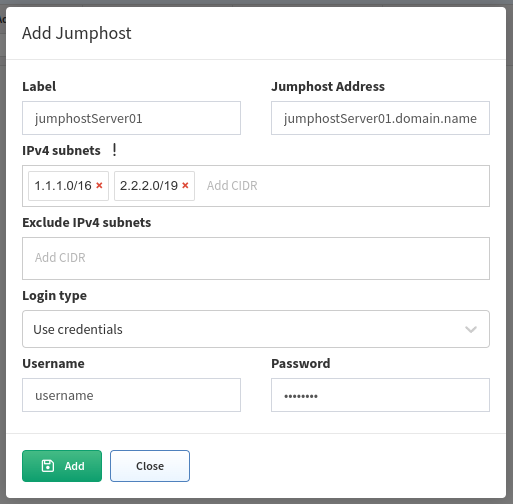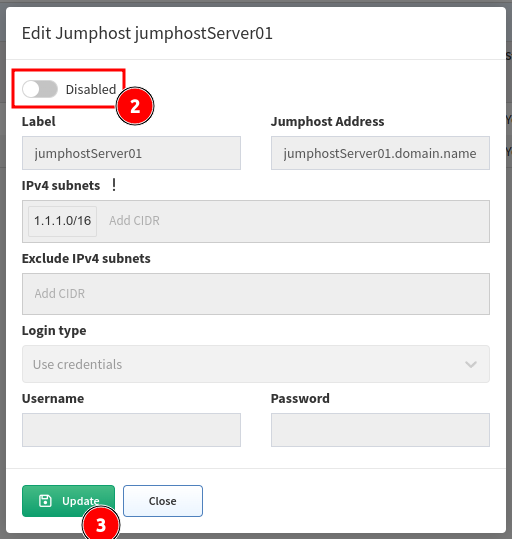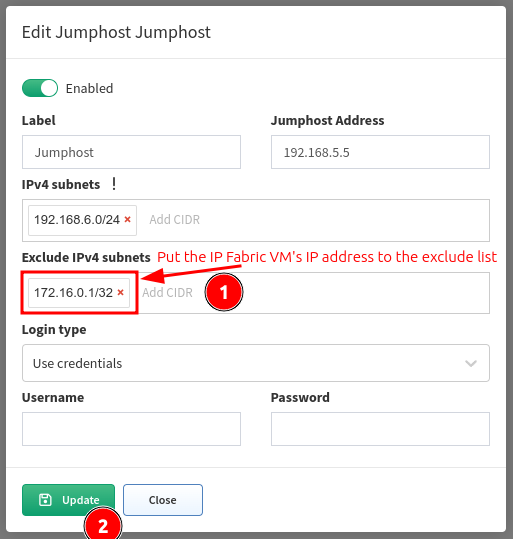Jumphost
Setting Up Jumphost
Jumphost allows setting up a connection to a server that can be used as a proxy server for discovery. IP Fabric uses an SSH tunnel established by Python on the client and server sides.
The user account used for jumphost connection must have access to the jumphost’s shell and must be able to run Python.
We successfully tested IP Fabric against jumphosts with the following Python versions:
| Jumphost’s Python Version | Status |
|---|---|
2.7 |
tested |
3.4 |
tested |
3.5 |
tested |
3.6 |
supported |
3.7 |
supported |
3.8 |
supported |
3.9 |
supported |
3.10 |
tested |
3.11 |
tested |
3.12 |
tested |
3.13 |
tested |
Tested vs. Supported
tested – Python version was successfully tested on a jumphost. However,
it is not officially supported by the underlying SSH tunnel project.
supported – Python version was successfully tested on a jumphost and is
officially supported by the underlying SSH tunnel project. We strongly
recommend using a supported Python version in your production environment.
Warning
Please bear in mind that once the connection is established, it will be enabled permanently until disabled or removed! If there are any network issues, IP Fabric will try to establish a connection periodically.
Important
In the Discovery Seeds settings, at least one IP address behind the jumphost has to be provided as a starting point.
Adding New Jumphost
-
Navigate to Settings → Discovery & Snapshots → Global Configuration → Jumphost.
-
On the page, click + Add:
-
Fill in all necessary data:
- Label – (mandatory) Name of the configuration.
- Jumphost Address – (mandatory) IP address or FQDN name.
- Port – (optional) Port number to connect. Defaults to the standard 22 if not specified.
-
IPv4 subnets – (mandatory) Subnet in CIDR representation. Allows adding more than one, separated with spaces. The subnet
0.0.0.0/0cannot be added here.Warning
If you use any subnet that includes IP Fabric’s IP address or the IP address of its default gateway, please add both of these IP addresses or the IP Fabric subnet to Exclude IPv4 subnet. Otherwise, the connection to IP Fabric will be lost, and you will not be able to access the IP Fabric GUI/CLI, requiring manual intervention to fix.
Also, if you have multiple jumphosts with IP addresses that are part of the include list of another jumphost, add these IP addresses to all the other jumphosts’ exclude lists.
- Exclude IPv4 subnets – (optional) Subnet to exclude in CIDR representation. Allows adding more than one, separated with spaces.
-
Login type
Use credentials– Required to provide username and password.
Use SSH keys– If you copied the SSH public key to the proxy server, it won’t require providing a password (please jump to the SSH Key Configuration section).
- Username – (mandatory) Username for authentication.
-
Password – (mandatory if
Use credentialsis selected) Password for authentication.Username and Password Character Restrictions
Username must match the following regular expression:
/^[A-Za-z0-9_][A-Za-z0-9\._-]*\$?$/- It must start with one of these characters:
A-Za-z0-9_ - It may contain any of these characters:
A-Za-z0-9._- $is only allowed once at the very end.
Password must match the following regular expression:
/^[A-Za-z0-9\.,\/_@%^:=+ -]*$/- It must contain only these characters:
A-Za-z0-9.,/_@%^:=+ -
- It must start with one of these characters:
-
Click the green Add button to save the configuration.
-
If the connection is open, you will see
Yesin theStatuscolumn in theJumphost settingstable:
SSH Key Configuration
Info
To avoid using a password for authentication, you can add the SSH key to the proxy server.
Copy SSH Key Manually
-
Download the SSH key from Jumphost settings:
-
Save
jumphost-public-key.pub. -
Insert the content of the
jumphost-public-key.pubfile into theauthorized_keysfile of the user that will authenticate with the jumphost server. Please follow the official documentation at https://www.ssh.com/academy/ssh/authorized-key.You can also use
ssh-copy-idon your machine to deploy the key (see below). -
After the key is transferred to the jumphost server, you can use the
Use SSH keysoption instead ofUse credentials.
Use ssh-copy-id
-
Log in to the IP Fabric CLI using the
osadminaccount. -
Change to the
autobossuser by runningsudo su - autoboss. -
Run
ssh-copy-idwith the specified identity file, replacing<jumphost-user>with the jumphost user and<jumphost-ip>with the IP or FQDN of the jumphost server:-
ssh-copy-id -i ~/.ssh/ipf-jumphost.pub <jumphost-user>@<jumphost-ip> -
When prompted for a password, use the jumphost user’s password.
-
-
To test, connect to the jumphost server via SSH with:
ssh <jumphost-user>@<jumphost-ip> -
If the key has been copied, you can use the
Use SSH keysoption instead ofUse credentials.
Disabling Jumphost Connection
-
Edit the configuration that needs to be disabled, i.e.:
-
Change the setting to
Disabled. -
Click Update.
Remove Jumphost Configuration
-
In the
Jumphost settingstable, select the server you want to remove. -
Click Delete.
-
(If SSH key authentication was enabled) Delete the inserted IP Fabric public key from the
authorized_keysfile on the jumphost server added in the SSH Key Configuration.
Jumphost Known Issues
Invalid Input Error When Saving Jumphost Configuration
This might be caused by one of the following requirements not being met:
- The jumphost’s IPv4 subnets must not contain the subnet
0.0.0.0/0.
- If a subnet in the jumphost’s IPv4 subnets contains either IP Fabric’s IP address or the IP address of its default gateway, then these IP addresses must be added to Exclude IPv4 subnets.
- The
127.0.0.0/8network must not be included in IPv4 subnets. If it is currently part of IPv4 subnets, it must be explicitly added to Exclude IPv4 subnets.
- The Username or Password configured for the jumphost must not contain any restricted characters.
Non-TCP Discovery
Only TCP connections work through the jumphost.
Traceroute with ICMP is not supported, so the discovery process might not be able to traverse the unreachable parts of the network (for example, sites separated by the provider’s network).
Due to this, you will have to add at least one IP address of a network device from each site to the Discovery Seeds settings.
IP Fabric Is Not Accessible After Saving Jumphost Configuration
If you can’t open the main GUI or connect to the IP Fabric machine via SSH, the subnet/IP address of the IP Fabric machine was most likely included in the jumphost configuration.
To fix this issue, you must have direct access to the virtual machine’s
CLI from the hypervisor, the password for the osadmin user account, and
follow these steps:
-
Log in to the virtual machine’s CLI with the
osadminaccount. -
Filter out the jumphost services with the
systemctl | grep ipf-jumphostcommand. Each configured jumphost has its ownID.osadmin@Appliance-5:~$ systemctl | grep ipf-jumphost ipf-jumphost@10001843.service loaded activating auto-restart ipf-jumphost (ID=10001843) -
Stop the jumphost service with the
sudo systemctl stop ipf-jumphost@<ID>.servicecommand and enter theosadminpassword:osadmin@Appliance-5:~$ sudo systemctl stop ipf-jumphost@10001843.service [sudo] password for osadmin: osadminaAppliance-5:~$ -
Check that the jumphost process is inactive with the
systemctl status ipf-jumphost@<ID>.servicecommand:osadmin@Appliance-5:~$ sudo systemctl status ipf-jumphost@10001843.service ● ipf-jumphost@10001843.service - ipf-jumphost (ID=10001843) Loaded: loaded (/lib/systemd/system/ipf-jumphost@.service; disabled; vendor preset: enabled) Active: inactive (dead) Jul 12 13:53:25 Appliance-5 sshuttle[671008]: ssh: connect to host 192.168.5.5 port 22: Network is unreachable Jul 12 13:53:25 Appliance-5 sshuttle[671008]: c : fatal: c : failed to establish ssh session (2) Jul 12 13:53:25 Appliance-5 start-one.sh[670989]: expect: read eof Jul 12 13:53:25 Appliance-5 start-one.sh[670989]: expect: set expect_out(spawn_id) "exp3" Jul 12 13:53:25 Appliance-5 start-one.sh[670989]: expect: set expect_out(buffer) "" Jul 12 13:53:26 Appliance-5 start-one.sh[671021]: Jul 12 13:53:25 [ERROR] Jumphost was not started Jul 12 13:53:26 Appliance-5 systemd[1]: ipf-jumphost@10001843.service: Control process exited, code=exited, status=1/FAILURE Jul 12 13:53:26 Appliance-5 systemd[1]: ipf-jumphost@10001843.service: Failed with result 'exit-code'. Jul 12 13:53:26 Appliance-5 systemd[1]: Failed to start ipf-jumphost (ID=10001843). Jul 12 13:53:36 Appliance-5 systemd[1]: Stopped ipf-jumphost (ID=10001843). -
The IP Fabric GUI should now be accessible.
-
Log in to the IP Fabric main GUI with your regular account and go to Settings → Discovery & Snapshots → Global Configuration → Jumphost.
-
Make a screenshot or copy the settings of the old jumphost. Then, delete or edit the jumphost settings.
-
Put the IP address/subnet of the IP Fabric machine to Exclude IPv4 subnets or edit the IPv4 subnets so it does not contain the IP address of IP Fabric:
Info
If IP Fabric becomes inaccessible via GUI or SSH again, repeat the previous steps and again edit the jumphost configuration.







